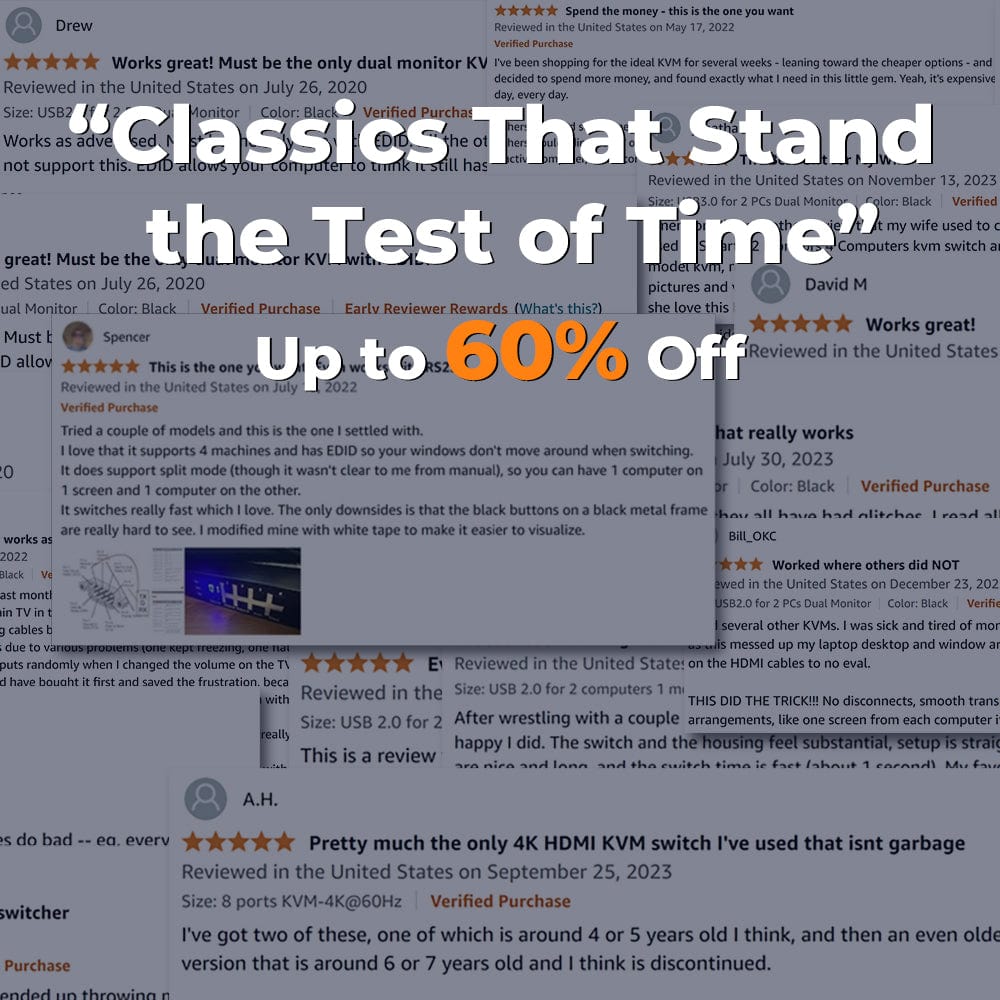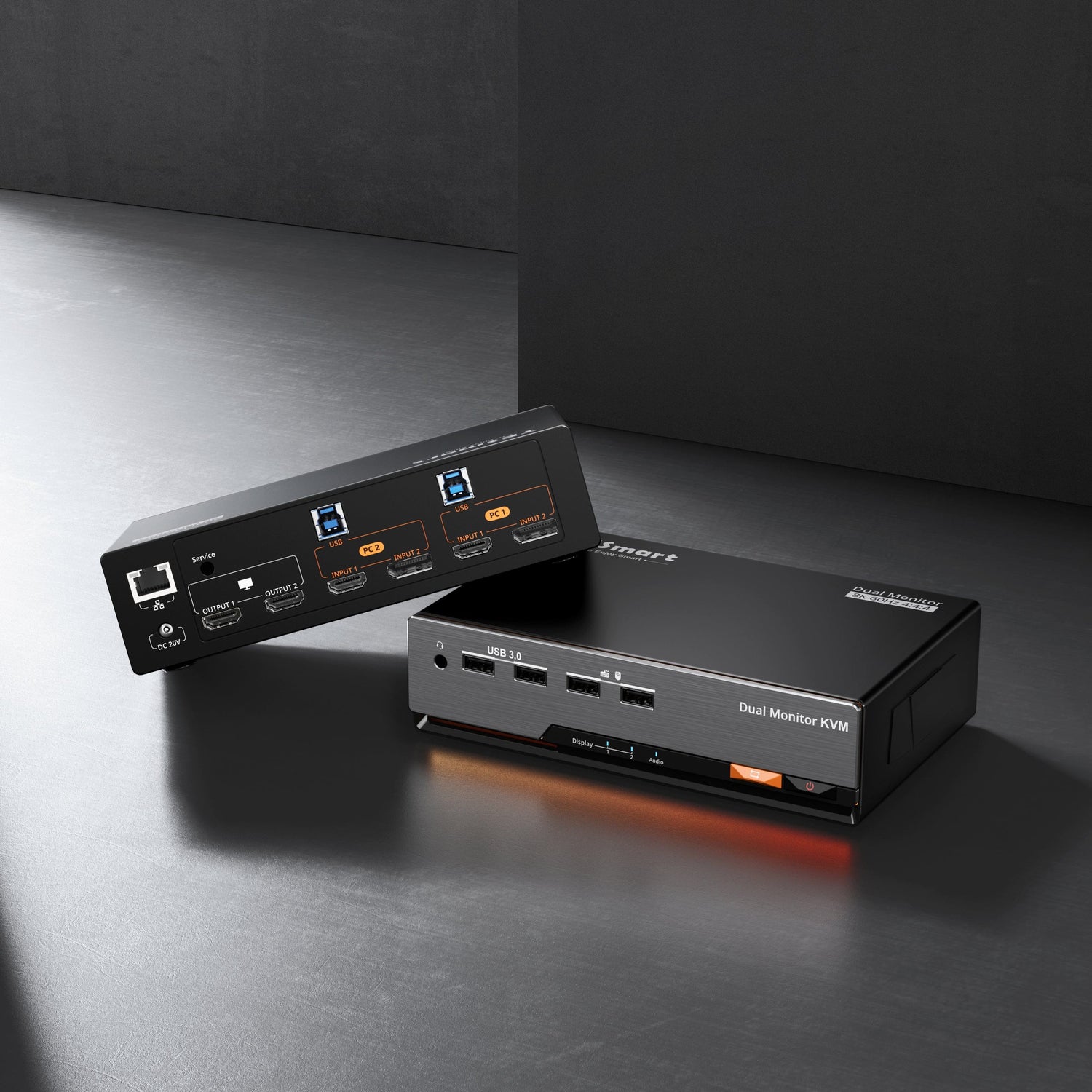Contents
DisplayLink Meets Extender: USB Connection + Cat6A Extension Enables 100m Dual-Screen Low-Latency Transmission
In modern professional workspaces, high-resolution dual-screen setups are no longer constrained by short cable lengths. With the rapid advancement of DisplayLink technology, dual-screen video, audio, USB, and Ethernet signals can now be transmitted over long distances while maintaining low latency and high fidelity. TESmart’s HKE10SS-PD25 seamlessly combines DisplayLink technology with HDBaseT extension, enabling dual-screen transmission up to 100 meters via a single Cat6A cable. This design simplifies wiring while supporting high-performance, multi-display workstations.


How DisplayLink Technology Works
The complete DisplayLink data chain can be divided into three stages:
1. Encode
Once the DisplayLink driver is installed on the host, the GPU’s video frame output is captured, compressed, and encoded into an efficient data stream. DisplayLink utilizes its proprietary DL Compression algorithm, which significantly reduces bandwidth usage while preserving lossless image quality.
2. Transfer
The encoded data stream is transmitted through the USB channel to the external device (such as the transmitter of the HKE10SS-PD25). USB 3.2 Gen 1 or higher interfaces provide up to 5Gbps bandwidth, sufficient to carry dual 4K video signals along with additional peripheral data.
3. Decode & Output
The receiver (containing the DisplayLink chip module) decodes the data stream in real time, restoring it to standard video signals that are output via HDMI or DisplayPort. Simultaneously, audio, network, and USB peripheral signals are distributed to their respective ports, ensuring seamless full-channel functionality. Through this architecture, DisplayLink achieves a highly integrated transmission across interfaces, protocols, and platforms.
Combining DisplayLink with HDBaseT Extension
While DisplayLink allows flexible USB-based video output, USB cable lengths are limited—typically less than 5 meters. By integrating HDBaseT technology into the HKE10SS-PD25, signals can travel up to 100 meters over a single Cat6A cable without quality loss. This hybrid design combines the strengths of both technologies: DisplayLink provides multi-display capability and USB convergence, while HDBaseT ensures stable long-distance transmission with low latency. The system also supports simultaneous transmission of audio, USB peripherals, and network traffic, making it an all-in-one extension solution.
Technical Flow Overview
- Host → Transmitter (TX): USB connection, DisplayLink driver installed
- TX → RX: Single Cat6A cable, up to 100 meters
- Receiver (RX): Outputs dual HDMI displays, USB devices (3× USB-A + 1× USB-C, USB 3.2 Gen 1), audio, and network

Why It Matters
Traditional video extension solutions often require multiple cables for HDMI, USB, and Ethernet, and rely on the computer’s native GPU outputs. This limits flexibility and portability, especially for laptops or compact PCs. The HKE10SS-PD25 addresses these challenges:
- One USB cable from the host replaces multiple separate cables
- DisplayLink enables dual-screen support without multiple GPU outputs
- HDBaseT ensures stable transmission up to 100 meters without frame drops or synchronization loss
This results in a cleaner, simpler, and more versatile workstation setup—ideal for offices, classrooms, control rooms, or digital signage environments that require high-definition video and low-latency KVM functionality.
Key Features of TESmart HKE10SS-PD25
DisplayLink-Based USB Video Transmission
Delivers dual-screen video, USB, audio, and Ethernet signals via a single USB connection to the transmitter.
100m Cat6A Transmission via HDBaseT
Supports up to 100 meters of stable transmission with minimal latency, ensuring smooth video playback and responsive USB peripherals.
Dual-Screen Output
Supports extended or mirrored dual-display configurations with resolutions up to 4K@60Hz, suitable for professional office and creative environments.
Multi-Platform Compatibility
Compatible with Windows, macOS, ChromeOS, and Linux systems. Hosts must install the official DisplayLink driver (where applicable) to enable virtual graphics output.
Plug-and-Play Extension Design
Once the DisplayLink driver is installed, all video, USB peripherals, audio, and network signals are immediately available at the remote receiver without additional configuration.
Integrated Audio & Network Support
Simultaneous transmission of audio and Ethernet signals simplifies remote workstation or presentation setups.
Remote Power-On/Off Support
By connecting an F-PANEL POWER SW splitter to the host motherboard, the RX unit can remotely control the host computer’s power, ideal for centralized management or remote boot (typically for desktop PCs).
Typical Use Cases
| Use Case | Deployment | Advantages |
|---|---|---|
| Corporate Offices | Host PC placed in a cabinet, connected to dual remote displays via network cable | Single USB connection, clean wiring, clear and stable display |
| Creative & Design Workstations | Designer’s host PC positioned away from the desk, dual-screen real-time display | Low latency, high color accuracy, seamless creative experience |
| Education & Training | Teacher’s host PC separated from podium terminals | Unified transmission of video, audio, and network, more flexible operation |
| Monitoring & Control Centers | Centralized host management, remote display control | Stable and efficient, supports multi-terminal collaboration |
FAQ
Q1: Can HKE10SS-PD25 support multiple displays?
Yes, it supports dual-screen setups via DisplayLink technology. Users can configure extended or mirrored displays through a single USB connection from the host, with resolutions up to 4K@60Hz.
Q2: What type of cable is required for 100m transmission?
To achieve full 100-meter low-latency transmission, a Cat6A cable is required. Standard Cat6 or shorter cables may limit distance or reduce performance.
Q3: Does it support keyboard, mouse, and USB peripheral extension?
Yes. The HKE10SS-PD25 provides 3 USB-A ports and 1 USB-C port on the RX unit, all supporting USB 3.2 Gen 1 (5Gbps). Users can connect a keyboard, mouse, and other USB peripherals, which can be directly controlled from the RX unit.
Q4: Is there any latency for audio, video, or USB signals?
Latency is minimal. Audio, video, and USB signals typically experience less than 1ms delay, ensuring real-time operation for professional and creative workflows.
Q5: Which computers can be remotely powered on/off?
The remote power-on/off function requires connecting an F-PANEL POWER SW splitter to the motherboard’s Power SW pins. This feature is generally only suitable for desktop PCs. Laptops are not recommended due to complicated disassembly and non-standard pin layouts. The RX unit can use this function for centralized management or remote boot.
Conclusion
By combining DisplayLink and HDBaseT, TESmart delivers a powerful solution for long-distance, low-latency dual-screen transmission. The HKE10SS-PD25 enables 100-meter transmission via a single host USB connection and a Cat6A cable, simplifying cabling while maintaining performance and responsiveness. This innovative design supports multi-display environments in offices, education, industrial monitoring, and digital signage—providing high performance, low latency, and flexibility, setting a new benchmark for workstation extension technology.






